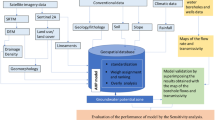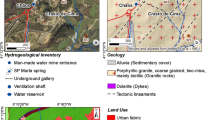Abstract
Europe has a long mining history, with some mining sites dating back to prehistoric times. Mining activities have boosted industrial development in many European countries; however, on the other hand, they left behind large degraded areas and polluted sites. This mining heritage, from small-scale mines to large industrial mining complexes, adversely affects natural resources and the environment. Exploration and mining of mineral ores have been quite extensive in Serbia. Most exploited were as follows: coal, copper, Pb–Zn ores, accompanying gold and silver and antimony. Groundwater resources are frequently impacted by mining operations, both during mining activities and after mine closure. For proper protection and management of groundwater resources, it is necessary to identify and characterize pollution sources within groundwater bodies. Abandoned mining sites, along with associated facilities for the preparation and processing of ores, waste rock disposal sites and tailings, constitute potential hazards and can have a negative effect on groundwater quality. This paper describes a methodology developed for regional-scale screening of the groundwater pollution risk from abandoned mining sites. As a first step, intrinsic groundwater vulnerability was assessed on the basis of readily available data. As potential polluters, 59 abandoned mining sites were included in the analysis. The hazard identification process comprised physical characterization of mining sites and hydrochemical assessment of mine water originating from those sites. A simple indexing method was developed for hazard and risk quantification. To assess the spatial distribution of the groundwater pollution risk, all data were incorporated and analyzed in a GIS environment. As a result of initial screening, several abandoned, mostly metallic mines were found to have higher-risk ratings for groundwater contamination. The methodology based on examples from Serbia can also be used in other regions for developing management strategies and directing of remediation activities.



Similar content being viewed by others
References
Atanacković N, Dragišić V, Stojković J, Papić P, Živanović V (2013) Hydrochemical characteristics of mine waters from abandoned mining sites in Serbia and their impact on surface water quality. Environ Sci Pollut Res 20(11):7615–7626. doi:10.1007/s11356-013-1959-4
Davis G, Butler D, Mills M, Williams D (1997) A survey of ferruginous mine water impact in the Welsh coalfields. J Chart Inst Water Environ Manag 11(2):140–146
Dragišić V (1995) An example of groundwater contamination due to a polluted mine waters impact. Proceeding of Symposium “Zaštita voda”, Tara, pp 130–134 (in Serbian)
European Commission (2006) Directive 2006/21/EC. The management of waste from extractive industries
Foster S (1987) Fundamental concepts in aquifer vulnerability, pollution risk and protection strategy. In: Van Duijevenboden W, Van Waegeningh HG (eds) Vulnerability of soil and groundwater to pollutants, vol 38. TNO Committee on Hydrogeological Research, Proceedings and Information, The Hague, pp 69–86
Foster S, Hirata R, Gomes D, D’Elia M, Paris M (2002) Groundwater quality protection, a guide for water utilities, municipal authorities, and environment agencies. The International Bank for Reconstruction and Development/The World Bank, Washington
Goldscheider N (2002) Hydrogeology and vulnerability of karst systems—examples from the Northern Alps and Swabian Alb, PhD Thesis (Dissertation), Fakultät für Bio-und Geowissenschaften, University of Karlsruhe, 236s, Karlsruhe
Hötzl H (2004) Risk assessment concept. In: Zwahlen F (ed) Vulnerability and risk mapping for the protection of carbonate (karst) aquifers, COST Action 620. European Commission, Directorate-General for Research, EUR 20912, Luxemburg, pp 108–112
Hudson-Edwards KA, Macklin MG, Brewer PA, Dennis IA (2008) Assessment of metal mining-contaminated river sediments in England and Wales. Science Report: SC030136/SR4, Environment Agency, Bristol
Mayes WM, Johnston D, Potter HAB, Jarvis AP (2009) A national strategy for identification, prioritization and management of pollution from abandoned non-coal mine sites in England and Wales. I. Methodology development and initial results. Sci Total Environ 407:5435–5447. doi:10.1016/j.scitotenv.2009.06.019
Official Gazette RS (2010) Official gazette of the republic of Serbia No. 110-00-299/2010-07
Rapantova N, Licbinska M, Babka O, Grmela A, Pospisil P (2013) Impact of uranium mines closure and abandonment on groundwater quality. Environ Sci Pollut Res 20(11):7590–7602. doi:10.1007/s11356-012-1340-z
Saaty TL (1994) Highlights and critical points in the theory and application of the Analytic Hierarchy Process. Eur J Oper Res 74(3):426–447. doi:10.1016/0377-2217(94)90222-4
Sima M, Zobrist J, Senila M, Levei EA, Abraham B, Dold B, Balteanu D (2008) Environmental pollution by mining activities—a case study in the Cris Alb catchment, Western Carpathians, Romania. Proceedings Swiss-Romanian research programme on environmental science &technology (ESTROM). Geo-Eco-Marina 14:9–21, ISSN: 2248–2776
Turner AJM, Braungardt C, Potter H (2011) Risk-based prioritisation of closed mine waste facilities using GIS. In: Rüde RT, Freund A, Wolkersdorfer Ch (eds) Mine water—managing the challenges, Aachen, Germany, p 667–671
UNESCO (2004) Groundwater resources of the world and their use. United Nations Educational, Scientific and Cultural Organization, Paris. ISBN 92-9220-007-0
Vrba J, Zoporozec A (eds) (1994) Guidebook on mapping groundwater vulnerability, vol 16. Hannover, International Contributions to Hydrogeology (IAH), p 131
Wang J, Chen J, Ju W, Li M (2010) IA-SDSS: a GIS-based land use decision support system with consideration of carbon sequestration. Environ Model Softw 25(4):539–553. doi:10.1016/j.envsoft.2009.09.010
Younger P, Wolkersdorfer C (2004) Mining impact on the fresh water environment: technical and managerial guidelines for catchment scale management. Mine Water Environ 23:s2–s80. doi:10.1007/s10230-004-0028-0
Živanović V (2011) Pollution vulnerability assessment of groundwater—examples of karst in Serbia, Msc Thesis. University of Belgrade. Faculty of mining and geology, Belgrade, p 1–215
Zobrist J, Sima M, Dogaru D, Senila M, Yang H, Popescu C, Roman C, Bela A, Frei BD, Balteanu D (2009) Environmental and socioeconomic assessment of impacts by mining activities-a case study in the Certej River catchment, Western Carpathians, Romania. Environ Sci Pollut Res 16(Suppl 1):S14–S26. doi:10.1007/s11356-008-0068-2
Acknowledgments
This research was supported by the Ministry of Education, Science and Technological Development (as a part of the Project No. 43004) and Ministry of Environment, Mining and Spatial Planning.
Author information
Authors and Affiliations
Corresponding author
Additional information
This article is a part of a Topical Collection in Environmental Earth Sciences on “Groundwater Vulnerability”, edited by Dr. Andrzej Witkowski
Rights and permissions
About this article
Cite this article
Atanacković, N., Dragišić, V., Živanović, V. et al. Regional-scale screening of groundwater pollution risk induced by historical mining activities in Serbia. Environ Earth Sci 75, 1152 (2016). https://doi.org/10.1007/s12665-016-5983-9
Received:
Accepted:
Published:
DOI: https://doi.org/10.1007/s12665-016-5983-9




